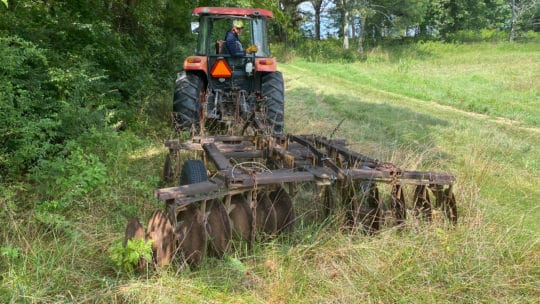In this Backyard Life video, MLF professional bass angler Andy Morgan discusses how to cut hay and bale it from his rural Tennessee farm. That’s right, when Morgan’s not on the water, you can usually find him at work on his property. Here, he talks about harvesting and baling hay. “It’s a great way to get some production out of your farm and earn a little extra income,” he says. Not to mention, “cattle’s got to eat, horses have to eat, and this is the process to get them fed through the winter.”
Phase 1: Mowing
To start, phase one of the hay harvesting process is mowing. “It’s as simple as it gets,” says Morgan. To expedite the process, Morgan uses two mowing machines, which he says cuts the cutting time in half. When you have a beautiful day, you want to get the hay cut fairly quickly, he explains. That way, you can get the hay down and start drying it.
Phase 2: Tedding
The next step is usually tedding: basically when fluffing or aerating the hay. This process flips the hay, kicking it over so that it dries better. But, since the humidity is so low on this particular day at Morgan’s place, he says it’s okay to skip the fluffing and move straight to raking and baling. This turns a four-step process into only three steps for Morgan.
Phase 3: Raking
To rake the hay, Morgan’s tractor pulls a giant rake that’s formed in a V shape. The rake pulls all of the hay to the center and forms it into a row. This way, the hay gets put into aisles or lanes, making it easy to pick it right up with his baler. But, Morgan cautions, you have to be certain the hay is dry before you rake. You can’t do this after a rain or even a dew.
After phase three, Morgan encounters a snafu: a bent valve stem on one of the tractor tires. It’s only a matter of time before the tire’s going to go flat. “That’s part of the farm project. It never goes as planned. So, never be surprised by what happens, because something’s always going to. It’s never as simple as it looks. Raking hay is really simple, but there’s always something else going on . . . An oil leak, a hydraulic leak, and, today, a broken valve stem,” says Morgan.
While he’s waiting for his tire to be fixed, Morgan tours the open shed that was built when he was a kid. “It still serves a purpose, we’ve just added onto it,” he explains. Morgan stores his baler in the shed, as well as the hay once it’s baled to keep it dry. “Moisture is your enemy when you’re cutting hay, or when you’re storing hay. Anything to do with hay, you don’t want any moisture,” he says.
Phase 4: The Final Process, Baling Hay
After you have cut hay, the final step is a bit more technical: the baler. Morgan assists hooking it to the tractor, but his buddy Jay knows how to work it a little faster than he does. The baler runs over the rows of hay, mashing and compacting it to form big rolls. Back in the shed, Morgan points to the end product: rows of hay bales.
Now that he’s done, Morgan says, “I’m going to the lake and to do some fishing. I may even have to go mow the yard with my Exmark. But, we’ll see. I hope Missy’s [his wife] already got that done. Catch you later.”



